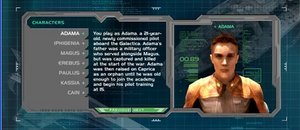William Adama (2003 Video Game)
- This article is about the characterization of William Adama from the 2003 video game. For information on the commander of battlestar Galactica in the Re-imagined Series, see William Adama.

Lt. William Adama, call-sign "Husker" (because of his rough voice) is the 21-year protagonist of the "Battlestar Galactica" video game from late 2003. The player assumes the role of "Husker" in the course of the game.
Adama's father had served in the Colonial military with Bryn Magus, and had saved his life more than once; he died during a skirmish with Cylons near Sagitara, when Adama was eight. Adama's mother died during childbirth. Raised on Caprica, Magus ensured that the orphaned boy was well cared for, partly to honour the debt he felt to the young Adama's father. Adama later joined the Colonial Academy at the age of 15. After graduating from officer training at the start of the Cylon War with honors, Commander Magus specifically requested him for assignment to his ship, the battlestar Galactica. Magus became a father-figure to him, and Adama fell in love with his daughter, Iphigenia Magus.
Along with Iphi, his wing men were Magus' son Paulus, and Lt. Garris Cain. Adama's Viper designation was Blue Four.
Cylon scrolls refer led them to believe that Adama will lead the Cylons to discover the Thirteenth Tribe; as such, he drew much interest from the Imperious Leader, Lord Erebus.
Note[edit]
The "Battlestar Galactica" video game has its own continuity that uses elements from both the Original Series and the Re-imagined Series.
In the Original Series, Commander Adama had married Ila. In the Re-imagined Series, the character of William Adama married Caroline and, later, Anne. This William Adama character has more in common with its Original Series counterpart than its Re-imagined Series character of the same name and call-sign, but is essentially a unique character.